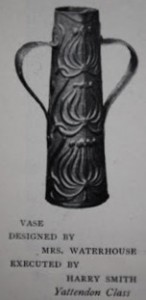The first in our series of favourite objects chosen by MERL staff, volunteers and visitors, is written by Fiona Melhuish, MERL Librarian.
In my work with the Special Collections rare books and MERL library I get lots of opportunities to spotlight my favourite items from our wonderful book collections through exhibitions and Featured Items on the Special Collections website, so for this post I am going to choose one of my favourite objects from the Museum’s collections – a Yattendon Guild copperware vase (MERL 2009/24).
This vase was purchased by MERL in 2009 as part of the Collecting Rural Cultures project which aimed to acquire material to build a picture of the countryside in the twentieth century. It was made at the Yattendon Metalworking Class, or Yattendon Guild, an evening class for local men and boys, organised by Elizabeth Waterhouse (1834-1918), the wife of the architect Alfred Waterhouse, whose buildings include the Natural History Museum in London. Alfred designed several buildings in Reading including East Thorpe, a Grade II listed building, which is now the home of MERL and Special Collections. The Waterhouse family purchased the Yattendon estate in West Berkshire in 1878, and Alfred built Yattendon Court (now demolished) as their family home.
Between 1890 and 1914, the class met weekly at Yattendon Court and developed into a thriving village industry. The class produced items in repoussé brass and copper mostly from Elizabeth’s own designs – she also taught her pupils how to beat the copper and brass. The metalworker Colin Pill (who has an interesting website devoted to Arts and Crafts metalwork) has pointed out that “the handle construction on [Yattendon] vases and tankards as well as the shallow nature of the repoussé and background punching or grounding are very distinctive”. Yattendon metalware does not appear to have been stamped with a maker’s mark but some pieces occasionally bear pen inscriptions.
The class became affiliated to the Home Arts and Industries Association (HAIA) which was established in 1884 to increase skills in craftsmanship among the working classes and to promote the revival of rural craft industries. Similar metalwork classes were set up in Newlyn in Cornwall and in Keswick in the Lake District.
The Yattendon Class established a reputation for good design, and produced items including plates, jugs and lanterns in an Arts and Crafts style. The decorative motifs were inspired by plants and flowers, whilst others featured peacocks, fish, deer and leopards. The class produced over 5,000 items and sold their wares in a local shop, whilst other items were sold at Liberty’s in London. In 1895 the art and design journal The Studio praised the Yattendon Guild’s “fine show of repoussé copper, excellent in its design and thoroughly characteristic of the metal”. This vase was featured in an article in The Studio in 1899.
The vase is one of several items with a Waterhouse connection held by MERL and Special Collections. The Museum also has a tankard made by the Guild (MERL 68/506) and Special Collections holds books written by Elizabeth, correspondence and watercolours by the Waterhouse family. Neither the tankard or the vase are currently on public display in the Museum at the moment but please contact us if you would like to visit to see them!
Objects made in the Arts and Crafts style have always appealed to me, with their designs drawn from natural forms. However, what I think is particularly special about this object is the numerous links it has with different parts of our collections, from the building in which our collections are housed to local history and to the rural life and craft traditions which the Museum seeks to document and celebrate. The design of the vase has a simple beauty and a very satisfying symmetry, with the stylised plant/seed head motif gradually reducing in size as the vase tapers upwards – it would look wonderful in an Arts and Crafts-style fireplace filled with teazels!





